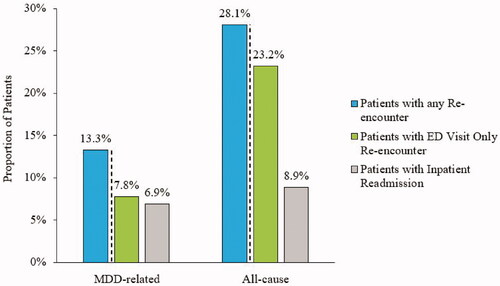Figures & data
Figure 1. Process of patient selection. aExcluded psychiatric comorbidities were bipolar disorder/manic depression, dementia, intellectual disability, schizophrenia, schizotypal, delusional, cluster b personality disorders, substance induced mood disorders and other non-mood psychotic disorders. Abbreviation. MDD, Major depressive disorder.

Table 1. Demographic and hospital characteristics of patients with hospital encounters for MDD.
Table 2. Clinical characteristics of patients with hospital encounters for MDD.
Figure 2. Mean charges and costs for index hospital encounters of patients with MDD. All charge and cost data are reported as mean ± standard deviation. Abbreviations. ED, Emergency department; MDD, Major depressive disorder.

Figure 3. Proportions of patients with any hospital re-encounter, an ED visit only re-encounter, and an inpatient readmission in the follow-up period. A patient may have had both an ED visit only re-encounter and inpatient readmission. Thus, the sum of the proportions with an ED visit only re-encounter and inpatient readmission may be greater than the percentage of patients with any hospital re-encounters. Abbreviations. ED, Emergency department; MDD, Major depressive disorder.

Figure 4. Distribution of time to hospital re-encountersa among patients with A) an MDD-related and B) all-cause hospital re-encounter in the follow-up period. aHospital re-encounters includes ED visit only re-encounters and inpatient readmissions. Abbreviations. ED, Emergency department; MDD, Major depressive disorder.

Table 3. Hospital re-encounter outcomes among patients with any hospital re-encounters during the 12-month follow-up period.
Data availability statement
All data generated or analyzed during this study are included in this published article or are available upon request from the corresponding author.
